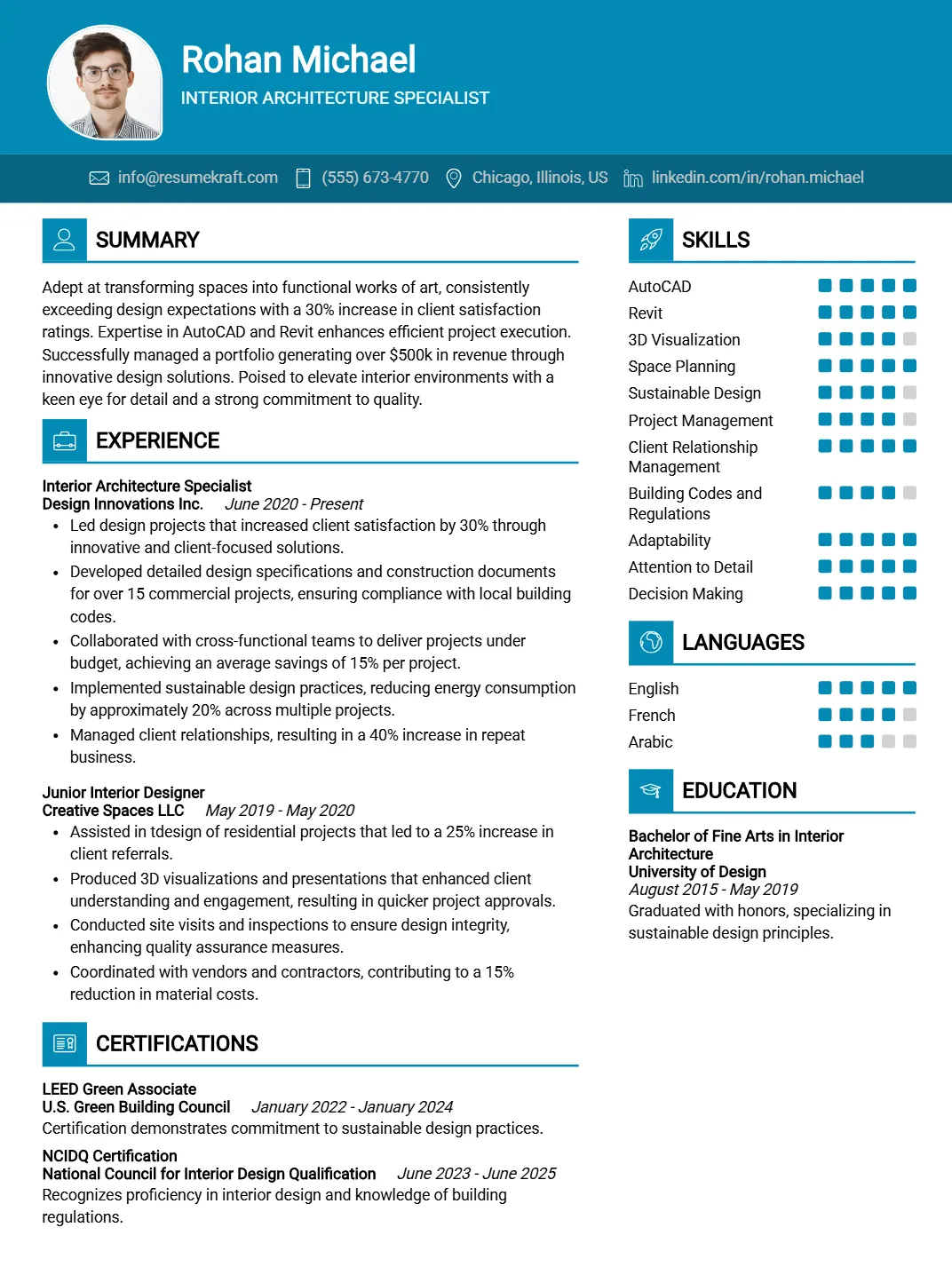
Architects play a pivotal role in shaping the built environment, blending creativity with engineering principles to design functional and aesthetically pleasing structures. This profession involves not only drafting blueprints but also considering sustainability, safety, and the social impact of their designs. In today’s job market, where urbanization and green building practices are on the rise, architects are in high demand to create innovative spaces that meet diverse needs. This article will provide insights on crafting a compelling resume that highlights your unique skills and experiences as an architect, ensuring you stand out in a competitive field.
- Architecture resume examples
- How to format a Architecture resume
- How to write your Architecture resume experience
- How to list your hard skills and soft skills on your resume
- How to list your certifications and education on your resume
- How to write your Architecture resume summary or objective
- Additional sections for a Architecture resume
- Key takeaways for writing a professional Architecture resume
- Frequently Asked Questions
Architecture resume examples
Architecture resume examples serve as valuable tools for job seekers aiming to create compelling resumes tailored to the architectural field. By examining these examples, candidates can grasp the essential elements that make an effective resume, such as highlighting design projects, technical skills, and relevant experience. This insight can enhance their ability to showcase their qualifications, ultimately increasing their chances of securing interviews and job offers in a competitive market.
Junior Architect Resume
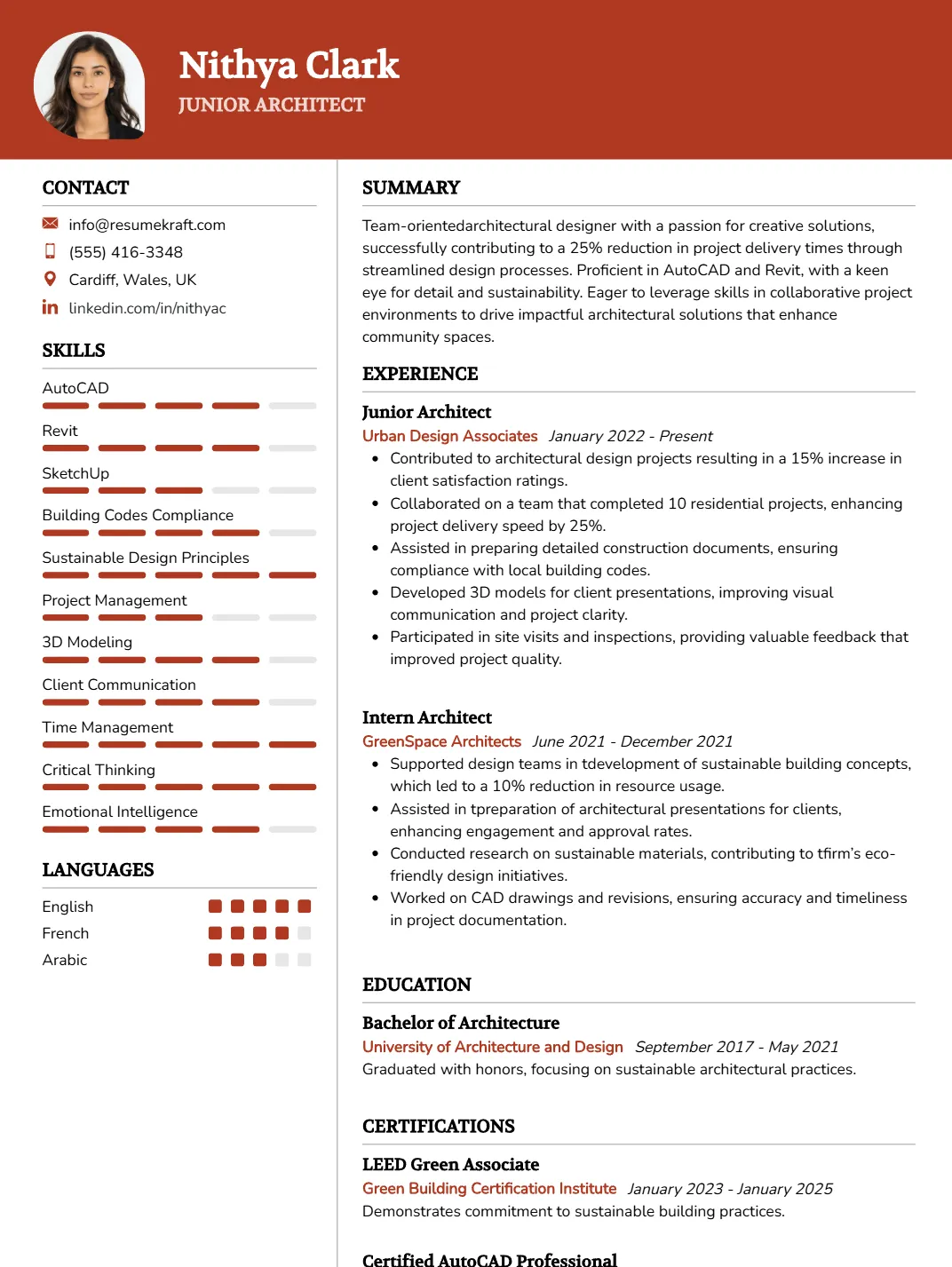
Why This Resume Works
This resume effectively positions the candidate for a Junior Architect role by highlighting essential skills like AutoCAD, Revit, and sustainable design principles, which are critical in modern architecture. With approximately three years of relevant experience as a Junior Architect and Intern Architect, it showcases practical application of knowledge in building codes compliance. The structured format enhances readability while ensuring ATS compatibility through strategic keyword usage. Additionally, the presentation of achievements emphasizes contributions to innovative projects, aligning with industry expectations and enhancing appeal to potential employers.
Senior Architect Resume
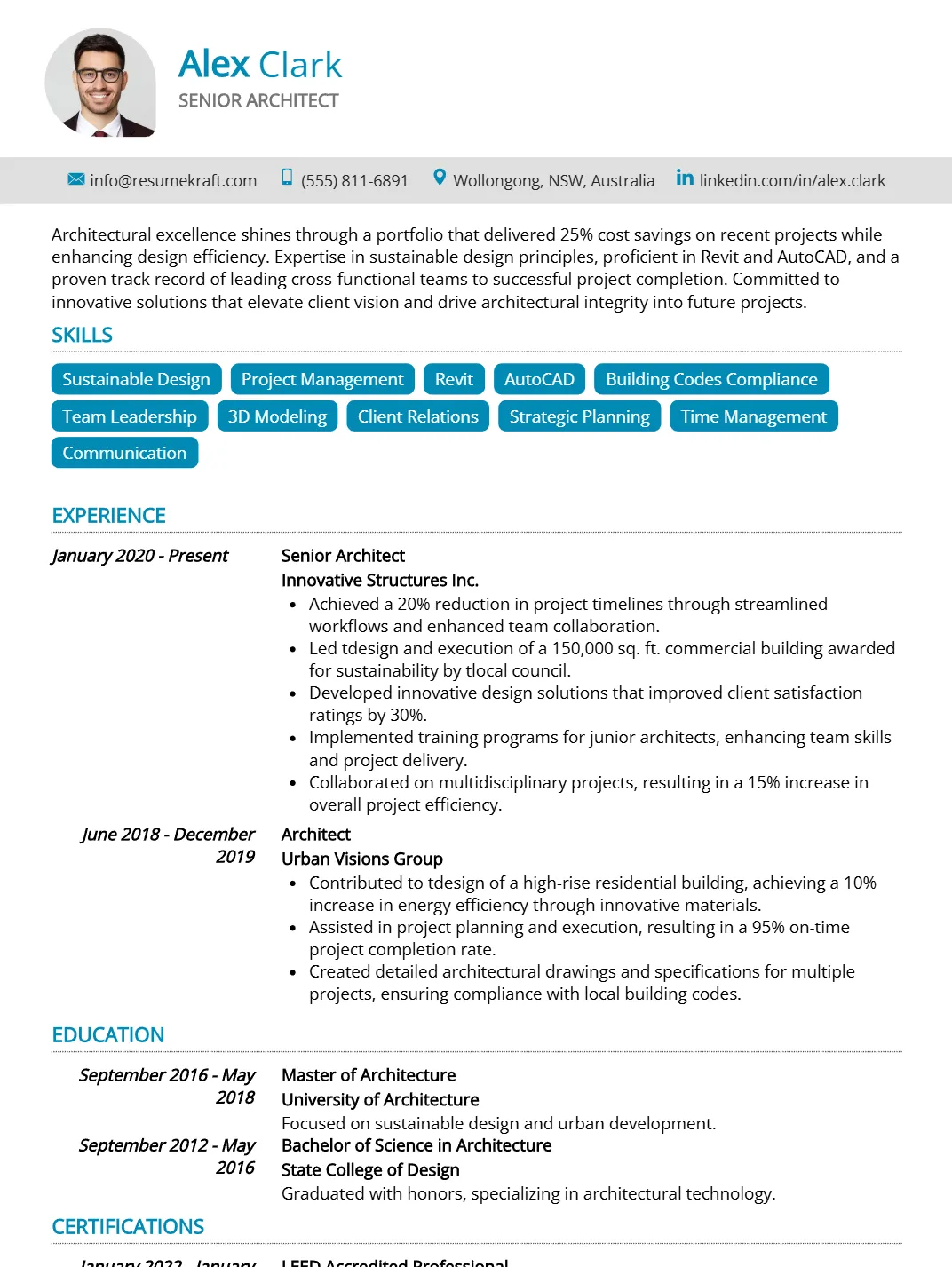
Why This Resume Works
This resume effectively showcases the candidate’s suitability for a Senior Architect position by highlighting essential skills such as Sustainable Design and Project Management, crucial for modern architectural practices. The clear, structured format enhances readability, allowing hiring managers to quickly identify qualifications. By incorporating industry-specific keywords, it ensures ATS compatibility, increasing visibility in applicant tracking systems. Additionally, the strategic presentation of relevant achievements emphasizes the candidate’s impact on previous projects, aligning perfectly with expectations for senior-level roles in architecture.
Mid-Level Architect Resume
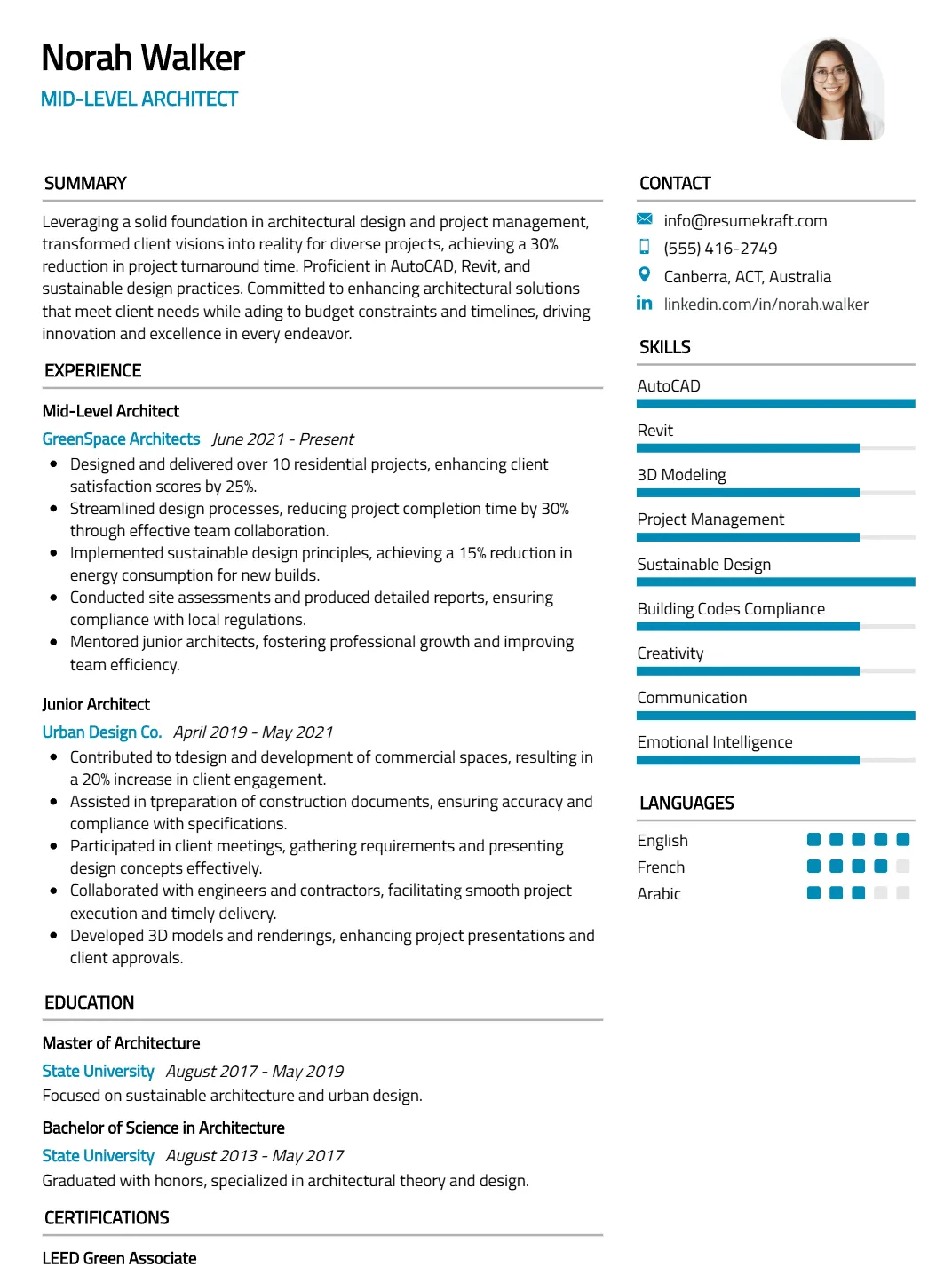
Why This Resume Works
This resume effectively highlights the candidate’s relevant skills, such as AutoCAD and Revit proficiency, crucial for a Mid-Level Architect role. With approximately six years of progressive experience, it demonstrates a solid foundation in project management and sustainable design. The structured format enhances readability, ensuring clarity for both hiring managers and ATS software. Strategic presentation of achievements showcases impactful contributions to previous projects, aligning with industry expectations and emphasizing the candidate’s capability to drive successful architectural outcomes.
Landscape Architecture Specialist Resume
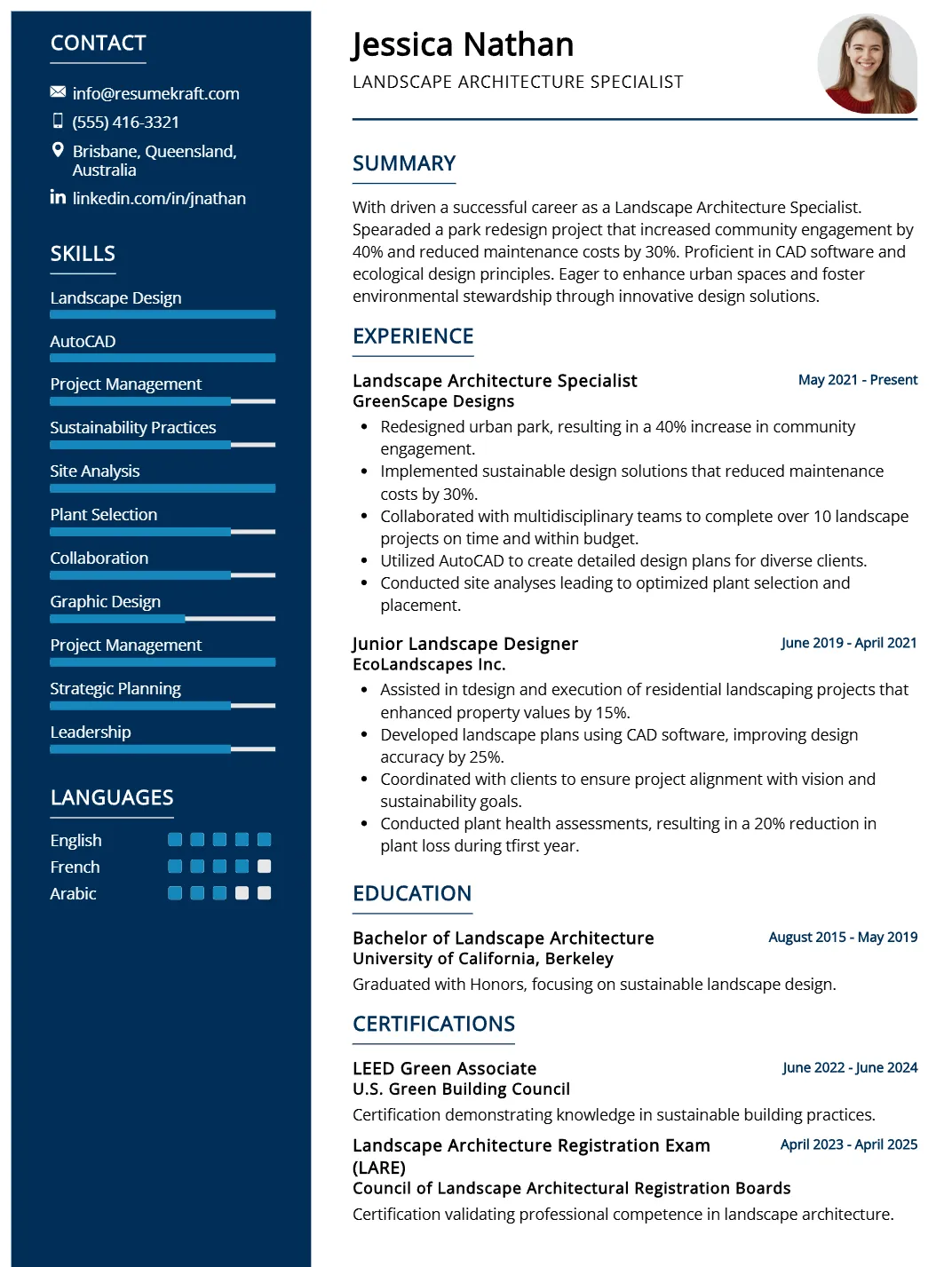
Why This Resume Works
This resume effectively positions the candidate for a Landscape Architecture Specialist role by highlighting relevant skills such as landscape design and sustainability practices, which are crucial in this field. The structured format clearly delineates professional experience, showcasing approximately six years in both specialist and junior roles, emphasizing progressive responsibility. Its ATS-friendly layout ensures key terms like AutoCAD and project management are easily recognized by hiring systems. Furthermore, strategic presentation of achievements reflects a commitment to innovative design solutions, aligning with industry standards and expectations.
Commercial Architect Resume
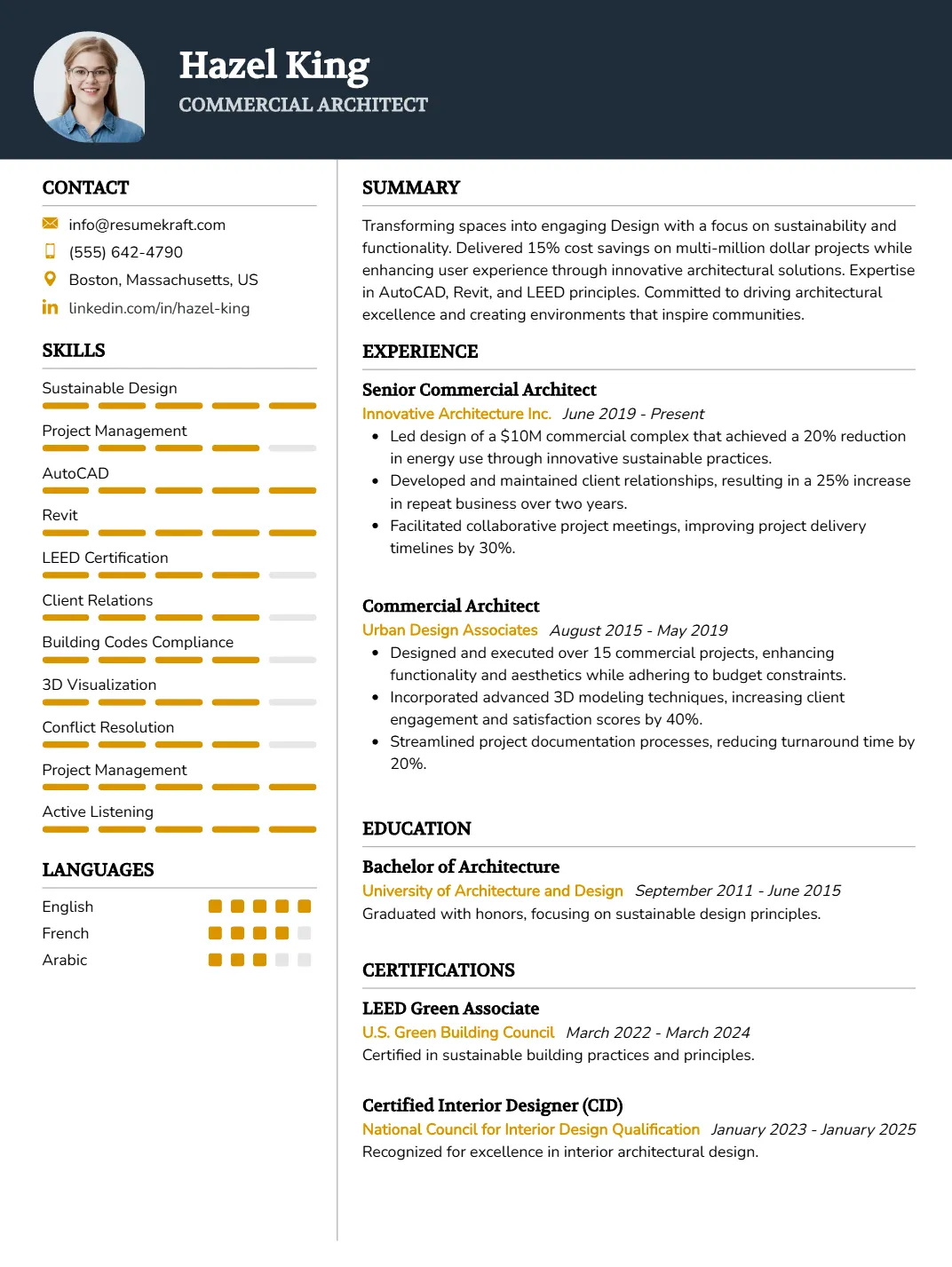
Why This Resume Works
This resume effectively highlights the candidate’s extensive experience as a Senior Commercial Architect, showcasing nearly 10 years in the field. Key skills such as Sustainable Design and LEED Certification align perfectly with industry demands, enhancing their appeal. The structured format emphasizes achievements in Project Management, while software proficiency in AutoCAD and Revit caters to technical requirements. Additionally, the use of relevant keywords ensures ATS compatibility, making it easier for hiring managers to identify qualified candidates for commercial architecture roles.
Urban Architect Resume
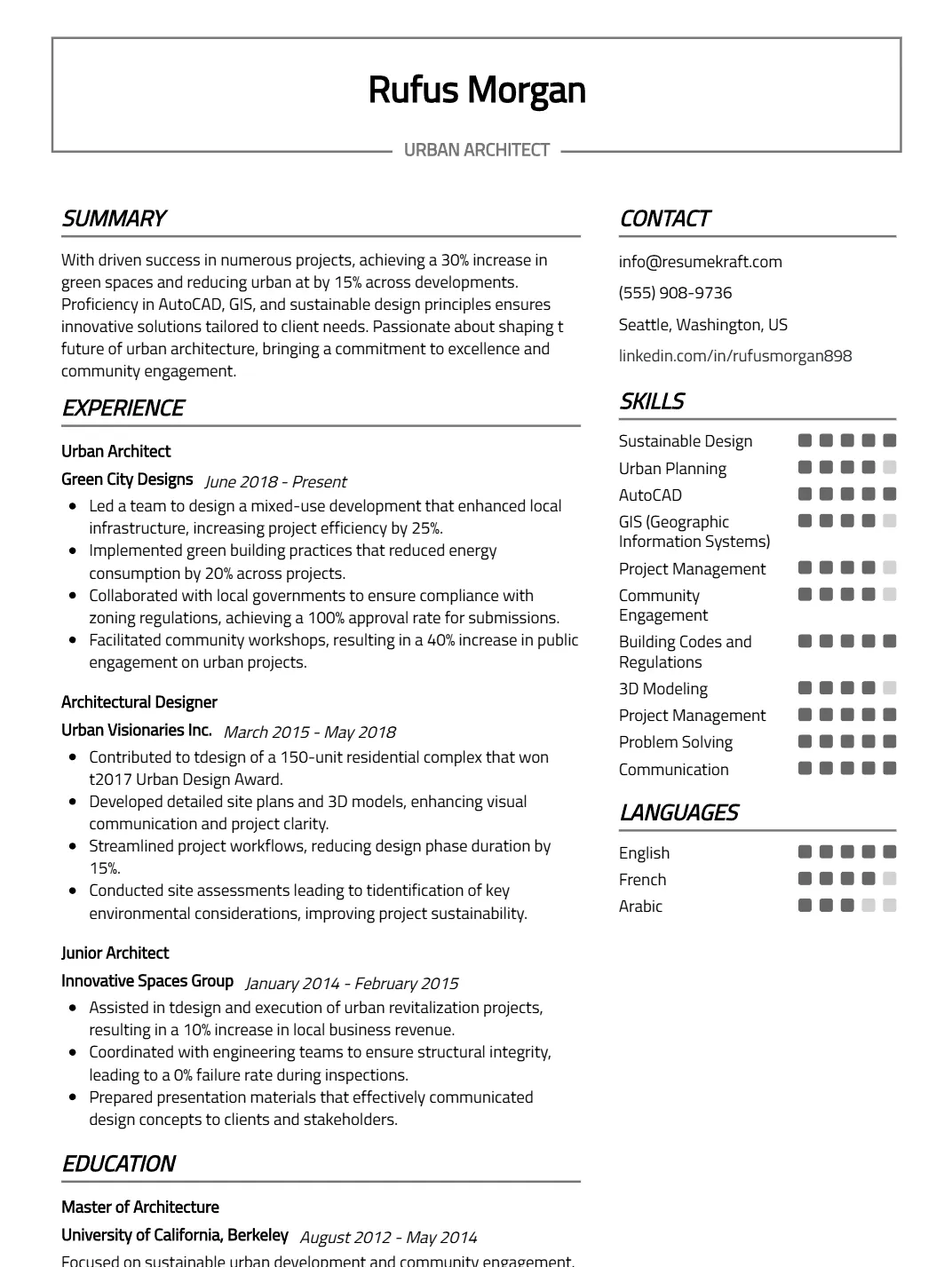
Why This Resume Works
This resume effectively positions the candidate for an Urban Architect role by prominently showcasing essential skills such as Sustainable Design and Urban Planning, crucial for modern urban development. With 11 years of relevant experience, including roles as Urban Architect and Architectural Designer, it demonstrates a strong career trajectory. The structured format enhances readability and highlights key achievements, ensuring ATS compatibility through the strategic use of industry-specific keywords.
Residential Architect Resume

Why This Resume Works
This resume effectively highlights the candidate’s extensive experience as a Senior Residential Architect, showcasing nearly nine years of expertise in residential design and sustainable architecture. The strategic presentation of key skills like Revit and AutoCAD emphasizes technical proficiency essential for this role. Its structured format ensures clarity, making it easy for hiring managers to identify relevant qualifications. Additionally, the use of industry-specific keywords enhances ATS compatibility, while well-defined achievements demonstrate the candidate’s ability to deliver successful residential projects, making them a compelling choice for the.
Sustainable Design Architect Resume
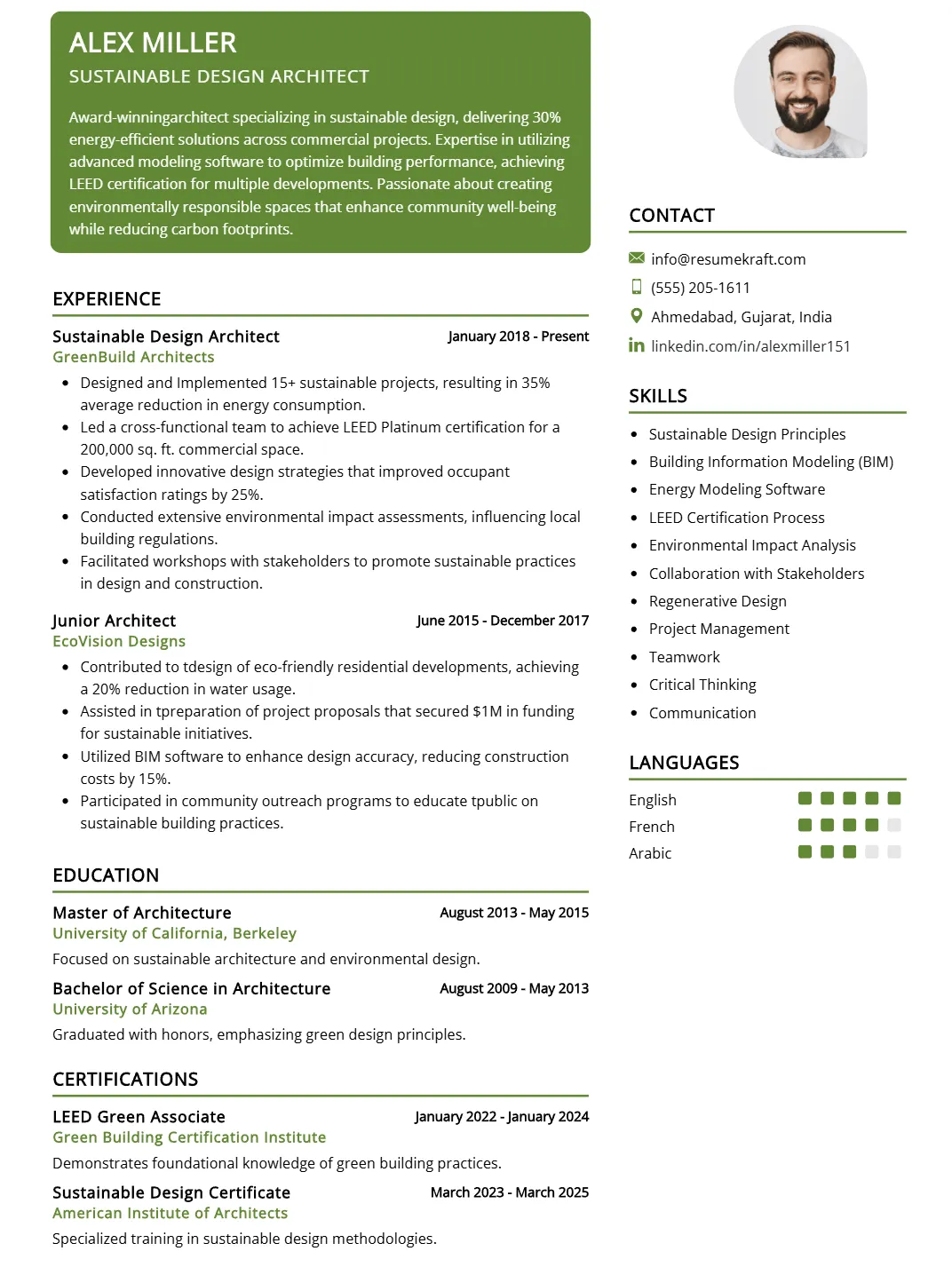
Why This Resume Works
This resume effectively positions the candidate for the Sustainable Design Architect role by highlighting key skills such as Sustainable Design Principles and LEED Certification, crucial for this field. The structured format allows for easy readability, showcasing nine years of relevant experience that demonstrates both depth and progression in sustainable architecture. Additionally, it incorporates industry-specific keywords to enhance ATS compatibility. Strategic presentation of achievements, focusing on energy efficiency and environmental impact, further aligns the candidate’s qualifications with the demands of sustainable design projects.
Healthcare Architect Resume
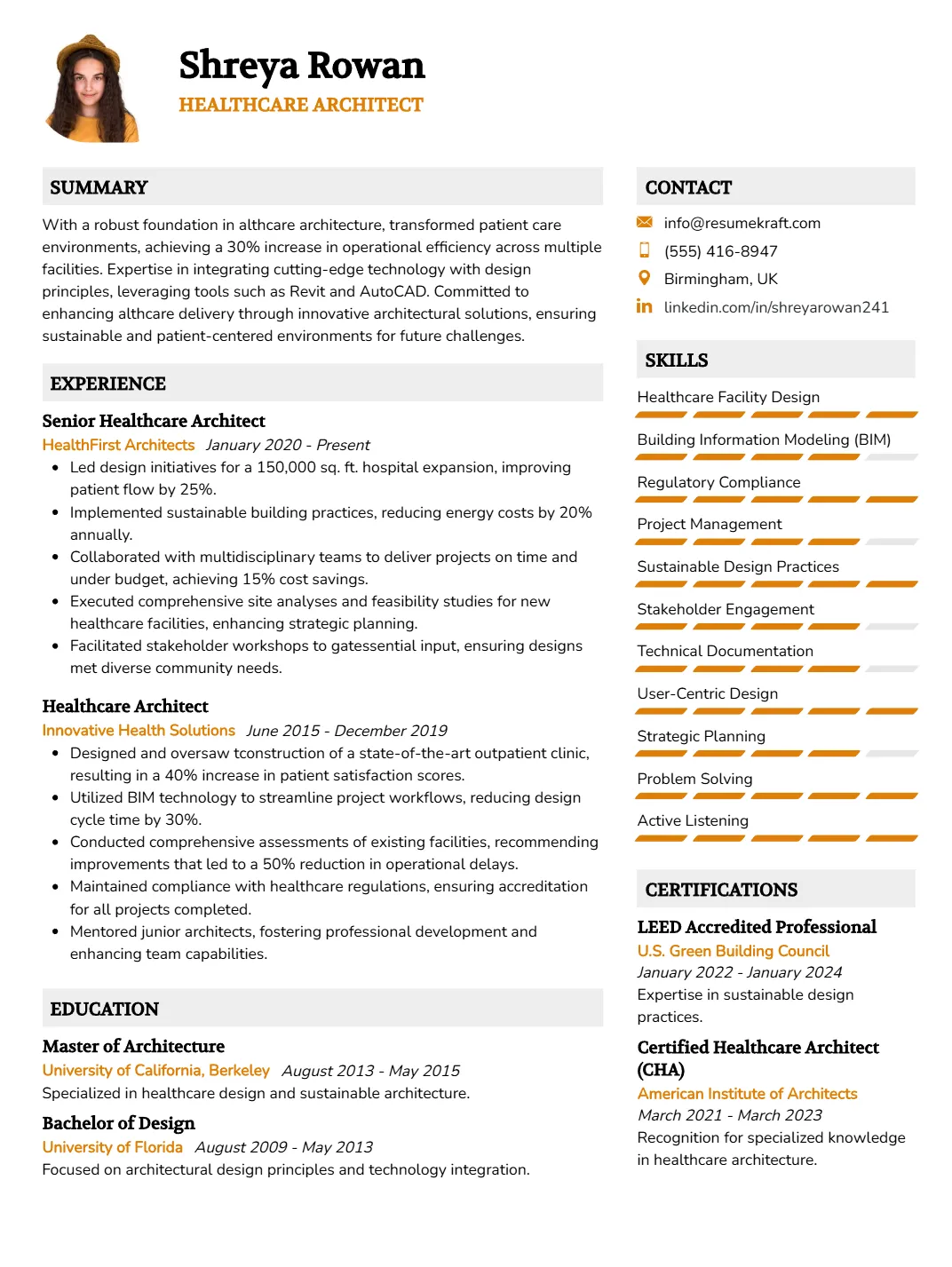
Why This Resume Works
This resume effectively highlights the candidate’s extensive experience and specialized skills in healthcare facility design, making it ideal for a Healthcare Architect position. The clear structure allows for easy navigation of key competencies like Building Information Modeling (BIM) and regulatory compliance, essential in this field. Its ATS-friendly format incorporates relevant keywords to enhance visibility, while strategically presented achievements underscore successful project management and sustainable design practices. Overall, it aligns perfectly with industry expectations, showcasing both technical expertise and practical accomplishments.
Historic Preservation Architect Resume
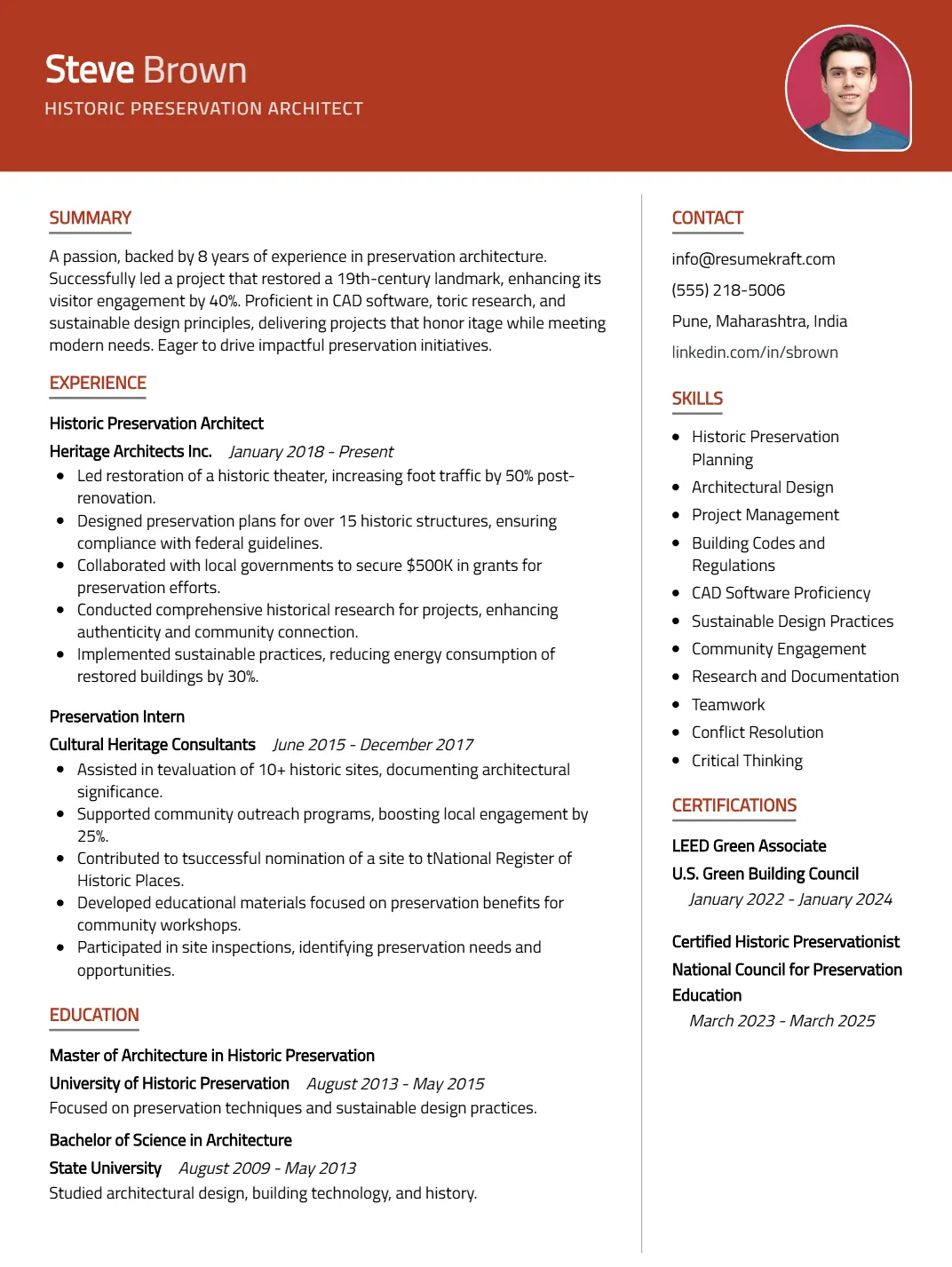
Why This Resume Works
This resume effectively showcases the candidate’s qualifications for a Historic Preservation Architect position through a clear focus on relevant skills like Historic Preservation Planning and Architectural Design. With approximately nine years of experience, including a dedicated role as a Historic Preservation Architect, the resume highlights valuable project management capabilities and familiarity with building codes. Its structured format enhances readability, ensuring ATS compatibility while strategically presenting achievements that resonate within the preservation field, thus positioning the candidate as an ideal fit for prospective employers.
Interior Architecture Specialist Resume

Why This Resume Works
This resume effectively highlights the candidate’s expertise as an Interior Architecture Specialist through a strategic focus on key skills like AutoCAD, Revit, and sustainable design. With approximately six years of relevant experience, it demonstrates a clear career progression from Junior Interior Designer to specialist. The format is well-structured for readability and aligns with industry standards, enhancing ATS compatibility. Additionally, the strategic presentation of achievements in space planning and 3D visualization showcases the candidate’s capability to contribute meaningfully to projects in this field.
Architectural Project Manager Resume
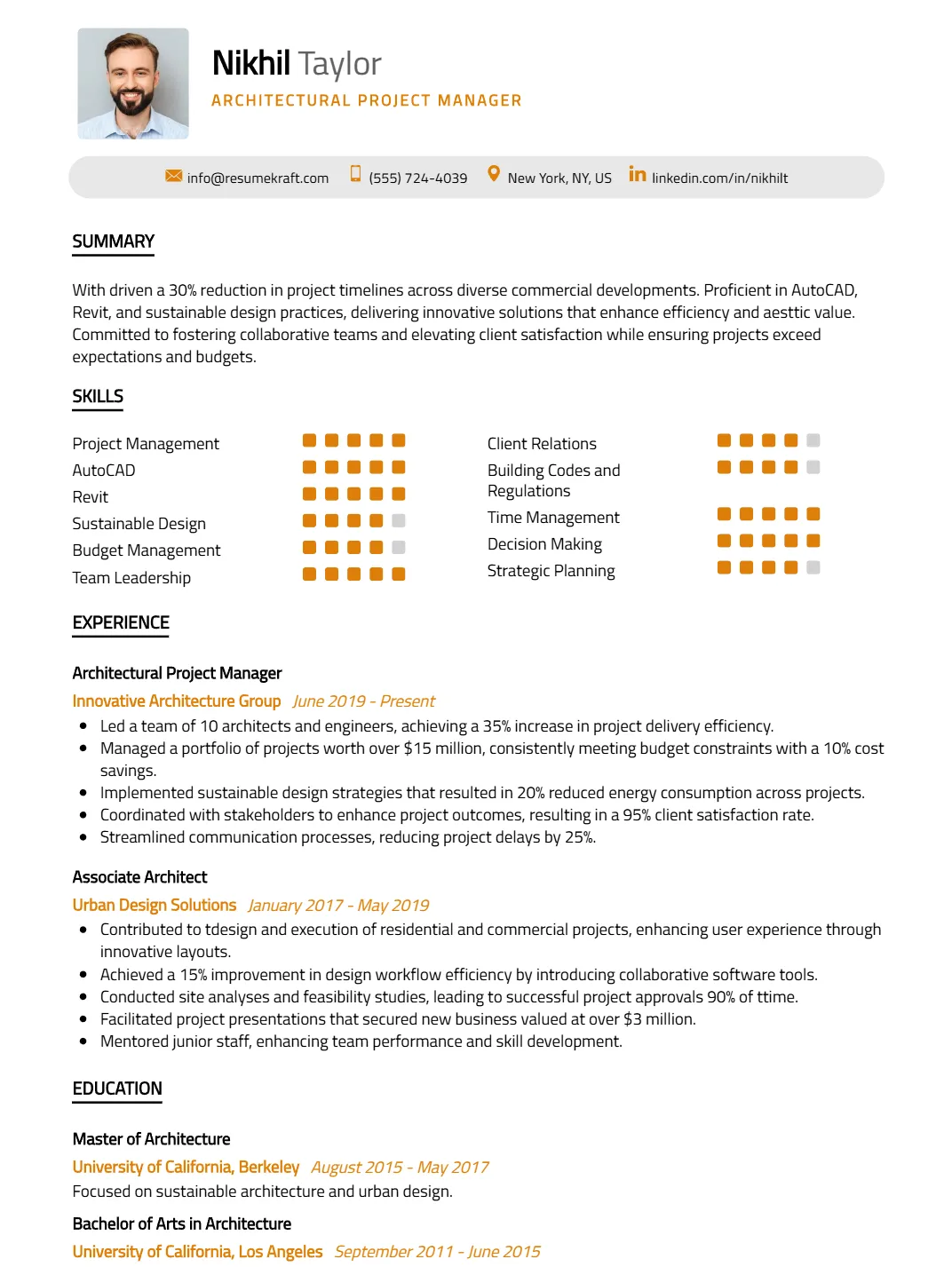
Why This Resume Works
This resume effectively highlights the candidate’s relevant skills and extensive experience as an Architectural Project Manager, showcasing expertise in project management, AutoCAD, Revit, and sustainable design. The structured format emphasizes key qualifications while ensuring ATS compatibility through strategic keyword usage. Additionally, the presentation of achievements demonstrates tangible results in budget management and project execution, appealing directly to industry standards. This focused approach makes the candidate highly competitive for the Architectural Project Manager role by aligning their background with essential job requirements.
How to format a Architecture resume
Proper formatting is crucial for an Architecture resume, as it not only enhances readability but also showcases your design sensibility. A well-structured resume format can make a significant difference in catching the attention of potential employers.
- Use clear section headings to differentiate between your experience, education, and skills. This allows hiring managers to quickly locate relevant information and assess your qualifications.
- Incorporate white space effectively to avoid clutter. A clean layout with appropriate margins and spacing enhances visual appeal and ensures your resume is easy to read.
- Opt for a professional font such as Arial or Helvetica, maintaining a size between 10-12 points. This ensures readability while reflecting a polished and modern design aesthetic.
- Align your text consistently, using left alignment for most sections. This uniformity creates a structured appearance that mirrors the precision expected in architectural work.
- Utilize bullet points for listing responsibilities and achievements. This format allows your accomplishments to stand out, making it easier for recruiters to scan your qualifications quickly.
How to write your Architecture resume experience
Effectively presenting work experience on an architecture resume is essential, as this section showcases your practical skills and achievements to potential employers. Employers seek candidates who can demonstrate a strong background in design, project management, and collaboration, as well as a proven ability to deliver innovative solutions within budget and timelines.
When detailing your work experience, focus on specific accomplishments and quantify your contributions where possible. This not only highlights your capabilities but also sets you apart from other candidates by providing tangible evidence of your impact in previous roles.
Worked on various architectural projects. Helped with designs and managed some tasks.
Designed and executed 10 residential projects, increasing client satisfaction by 30% and reducing costs by 20% through efficient resource management.
How to list your hard skills and soft skills on your resume
In the field of architecture, both hard and soft skills play a crucial role in shaping a successful career. Hard skills, such as proficiency in design software and knowledge of building codes, are essential for executing technical and design aspects of projects. Meanwhile, soft skills like communication and teamwork are vital for collaborating with clients and multidisciplinary teams, ensuring that visions are effectively translated into reality. Balancing these skills is key to thriving in the competitive architecture industry.
Hard Skills:
- AutoCAD: Proficient in creating detailed architectural drawings and plans.
- Revit: Experienced in Building Information Modeling (BIM) for project visualization.
- 3D Modeling: Skilled in using software like SketchUp and Rhino for design presentations.
- Building Codes: Knowledgeable about local and national building regulations and standards.
- Site Analysis: Ability to assess land and environmental factors affecting design.
- Construction Documents: Expertise in preparing and interpreting technical documentation.
- Design Software: Familiar with Adobe Creative Suite for graphic design and presentations.
- Material Knowledge: Understanding of various construction materials and their applications.
- Structural Systems: Knowledgeable in the fundamentals of structural engineering principles.
- Project Management: Capable of managing project timelines and resources effectively.
- Cost Estimation: Proficient in estimating project costs and budget management.
- Presentation Skills: Skilled in delivering compelling presentations to stakeholders.
- Zoning Laws: Familiar with land use regulations and compliance requirements.
- Environmental Design: Expertise in sustainable design practices and green architecture.
- Detailing: Ability to create precise and comprehensive construction details.
Soft Skills:
- Communication: Strong verbal and written skills for client and team interactions.
- Collaboration: Ability to work effectively in multidisciplinary teams.
- Creativity: Innovative thinking to develop unique design solutions.
- Problem-Solving: Aptitude for identifying issues and generating practical solutions.
- Time Management: Efficiently managing multiple projects and deadlines.
- Adaptability: Flexibility to adapt designs based on feedback and changing circumstances.
- Attention to Detail: Precision in design and documentation to prevent errors.
- Leadership: Capable of leading project teams and mentoring junior staff.
- Negotiation: Skilled in negotiating project terms and resolving conflicts.
- Client Relations: Building and maintaining strong relationships with clients.
- Critical Thinking: Evaluating design options and making informed decisions.
- Empathy: Understanding client needs and translating them into design concepts.
- Networking: Ability to build professional relationships within the industry.
- Resilience: Maintaining composure and focus under pressure.
- Vision: Ability to conceptualize and articulate design ideas effectively.
How to list your certifications and education on your resume
When presenting certifications and education on an architecture resume, it’s important to highlight qualifications that are directly relevant to the field. Include your degree in architecture, any specialized training, and relevant certifications such as LEED accreditation or a professional license. Organize this information in reverse chronological order, ensuring the most recent and relevant qualifications are easily identifiable to potential employers.
Additionally, consider including any honors or distinctions achieved during your studies. This can enhance your credibility and showcase your commitment to excellence in architecture. Use bullet points for clarity and ensure that each entry includes the institution, degree, and graduation date or certification date for a professional presentation.
Graduated from a school and got some certifications related to architecture.
Bachelor of Architecture, University of XYZ, May 2022; LEED Green Associate, 2023; Licensed Architect in State ABC, 2023.
How to write your Architecture resume summary or objective
A strong resume summary or objective is crucial for architecture positions as it serves as a brief introduction to your qualifications and aspirations. A well-crafted summary highlights your experience and skills, making it easy for hiring managers to quickly grasp your value. In contrast, an objective statement focuses on your career goals and what you aim to achieve in the role, making it more suitable for entry-level candidates or those transitioning into architecture.
Seeking an architecture position where I can use my skills. I am passionate about design and want to grow in the field.
Results-driven architect with 5+ years of experience in sustainable design, seeking to leverage expertise in innovative building solutions to enhance project efficiency at XYZ Firm.
Additional sections for a Architecture resume
Including additional sections on your architecture resume can significantly enhance your candidacy by showcasing your unique qualifications and experiences. These sections can highlight specific competencies, certifications, and achievements that align with the demands of the architecture industry, making your resume stand out to potential employers.
- Professional Certifications: Listing relevant certifications, such as LEED or PMP, demonstrates your commitment to industry standards and sustainability, which are highly valued in modern architectural practices.
- Project Portfolio: Including a link to a digital portfolio allows employers to visually assess your design style and capabilities, providing concrete evidence of your skills and creativity in real-world applications.
- Technical Skills: Highlighting software proficiency in tools like AutoCAD, Revit, and SketchUp shows your technical competency, which is crucial for producing architectural designs and collaborating with other professionals.
- Awards and Recognitions: Showcasing any awards or recognitions can differentiate you from other candidates, reflecting your excellence and innovation in architectural projects and contributing to your credibility.
- Professional Affiliations: Membership in organizations like the American Institute of Architects (AIA) indicates your engagement with the architectural community and your commitment to ongoing education and networking within the field.
Key takeaways for writing a professional Architecture resume
- Tailor your Architecture resume to highlight relevant projects, skills, and software proficiency, ensuring alignment with the job description to capture the employer’s attention.
- Use clear, concise language and strong action verbs to describe your responsibilities and achievements, demonstrating your impact and expertise in each role.
- Consider utilizing resume templates that cater specifically to the architectural field, helping you present your information in an organized and visually appealing manner.
- Incorporate a professional summary at the start of your resume, showcasing your unique qualifications and design philosophy to engage hiring managers immediately.
- Leverage an ai resume builder to refine your content, ensuring optimal keyword usage and formatting that adheres to industry standards, enhancing your chances of passing ATS.
Frequently Asked Questions
How long should my Architecture resume be?
Your Architecture resume should ideally be one to two pages long. If you have less than 10 years of experience, aim for one page to keep it concise. For those with more extensive experience, two pages allow you to elaborate on your projects, skills, and professional history. Always prioritize clarity and relevance over length; ensure each detail adds value and demonstrates your qualifications as an architect.
What is the best format for a Architecture resume?
The best format for an Architecture resume is the reverse-chronological format. This layout highlights your most recent experiences first, making it easier for hiring managers to see your latest projects and accomplishments. Use clear section headings for easy navigation, and incorporate bullet points for your responsibilities and achievements. A clean, professional design with a balance of white space enhances readability and showcases your attention to detail, which is crucial in the architecture field.
What should I highlight on my Architecture resume to stand out?
To stand out, highlight your technical skills, design software proficiency (e.g., AutoCAD, Revit), and any specialized areas such as sustainable design or urban planning. Include noteworthy projects, particularly those with awards or recognitions, and describe your role and contributions. Additionally, emphasize collaboration with multidisciplinary teams, effective communication with clients, and your ability to manage deadlines and budgets. Tailoring your resume to the specific job description can also help you catch the employer’s attention.
What are some ways to quantify my experience on my Architecture resume?
Quantifying your experience is crucial for demonstrating impact. Use metrics such as project budgets, timelines, and the number of projects completed. For example, you might say, “Designed a residential complex with a budget of $3M, completed 2 months ahead of schedule.” Additionally, highlight improvements you’ve made, such as reducing costs by a certain percentage or increasing energy efficiency in designs. These figures provide tangible evidence of your skills and contributions in the field of architecture.

